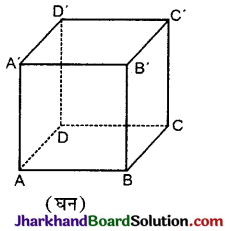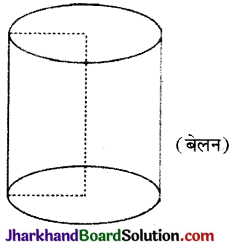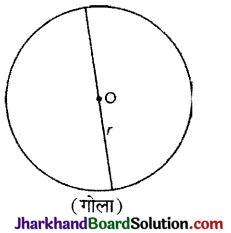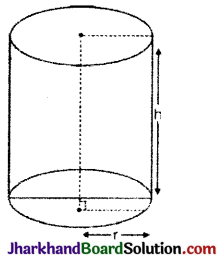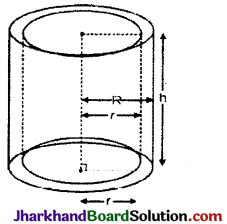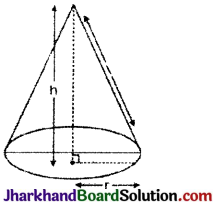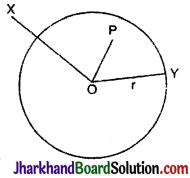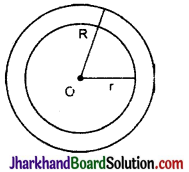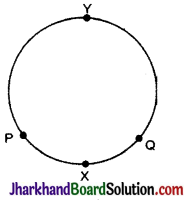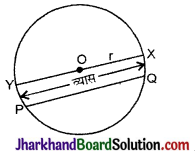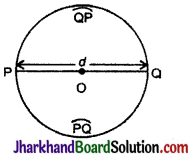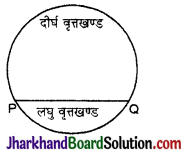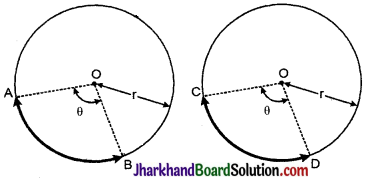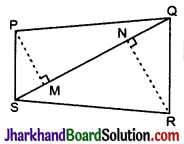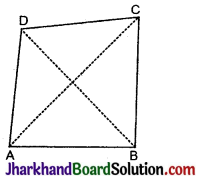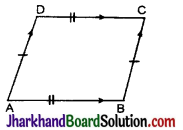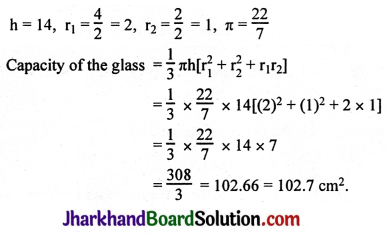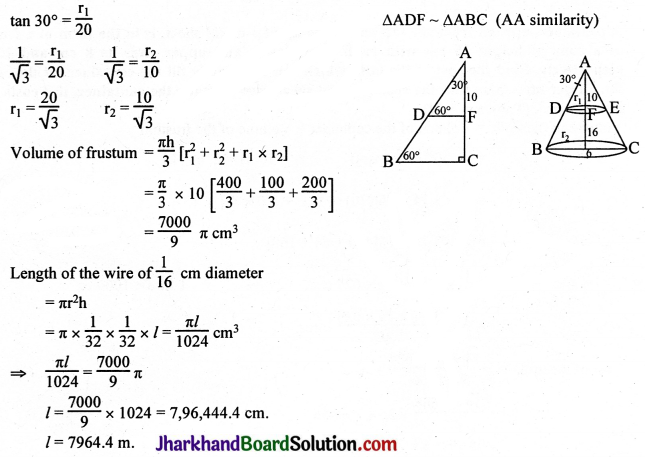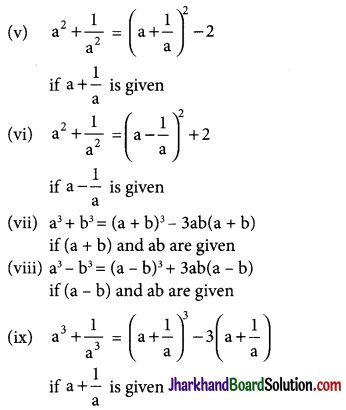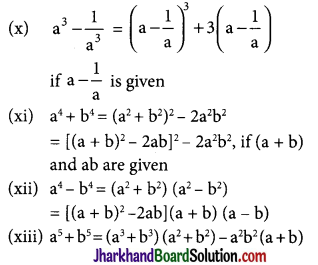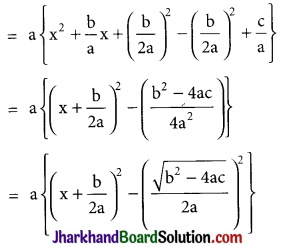Jharkhand Board JAC Class 9 English Solutions Beehive Chapter 3 The Little Girl Textbook Exercise Questions and Answers.
JAC Board Class 9 English Solutions Beehive Chapter 3 The Little Girl
JAC Class 9 English The Little Girl Textbook Questions and Answers
Thinking About the Text
I. Given below are some emotions that Kezia felt. Match the emotions in Column A with the items in Column B.
नीचे वे भाव (emotion) दिये गये हैं जिन्हें केजिया महसूस करती थी । कॉलम A में दिये गये भावों (emotions) का कॉलम B में दी गयी बातों से मिलान कीजिये
| Column A | Column B |
| 1. fear or terror | (i) father comes Into her room to give her a goodbye kiss |
| 2. glad sense of relief | (ii) noise of the carriage grows fainter |
| 3. a ‘funny’ feeling, perhaps of understanding | (iii) father comes home |
| (iv) speaking to father | |
| (v) going to bed when alone at home | |
| (vi) father comforts her and falls asleep | |
| (vii) father stretched out on the sofa snoring |
Answer:
| Column A | Column B |
| 1. fear or terror | (i) father comes Into her room to give her a goodbye kiss |
| 2. glad sense of relief | (iii) father comes home |
| 3. a ‘funny’ feeling, perhaps of understanding | (iv) speaking to father |
| (v) going to bed when alone at home | |
| | (vii) father stretched out on the sofa snoring |
| (ii) noise of the carriage grows fainter | |
| (vi) father comforts her and falls asleep |
II. Answer the following questions in about 30 words each:
निम्नलिखित प्रत्येक प्रश्न का उत्तर लगभग 30 शब्दों में दीजिये :
Question 1.
Why was Kezia afraid of her father ?
केजिया अपने पिता से क्यों डरी हुई थी ?
Answer:
Kezia was afraid of her father because he (father) never spoke kindly to her. He was very strict in his behaviour. He never played with her. She was panic stricken when he looked at her over his spectacles.
केजिया अपने पिता से इसलिए डरी हुई थी क्योंकि वे उससे कभी भी दयालुता से बात नहीं करते थे । उनका व्यवहार अत्यधिक कठोर था । वह कभी भी केजिया के साथ नहीं खेलते थे। जब वह अपने चश्मे को लगाकर उसमें से उसे देखते थे तो वह बहुत घबरा जाती थी।
Question 2.
Who were the people in Kezia’s family ?
केजिया के परिवार में कौन-कौन लोग थे ?
Answer:
There were only four persons in Kezia’s family. They were – her father, mother, grandmother and Kezia herself. Besides, the cook Alice was also there who looked after her in her mother’s absence.
केजिया के परिवार में केवल चार लोग थे । वे थे उसके पिता, माँ, दादी माँ और स्वयं केजिया । इसके अतिरिक्त एलिस नामक महिला रसोइया भी थी जो उसकी माँ केजिया की अनुपस्थिति में उसकी देखभाल करती थी।
Question 3.
What was the Kezia’s father’s routine :
(i) before going to his office ?
(ii) after coming back from his office ?
(iii) on Sundays ?
केजिया के पिताजी की दिनचर्या क्या थी
(i) दफ्तर जाने से पहले ?
(ii) दफ्तर से लौटकर घर आने पर ?
(iii) हर रविवार को ?
Answer:
Kezia’s father’s routine was that –
केजिया के पिता की दिनचर्या थी
(i) Before going to office he came into Kezia’s room and gave her a casual goodbye kiss.
दफ्तर जाने से पहले वह केजिया के कमरे में आते और उसे विदाई के समय का हल्के अंदाज में चुम्बन देते थे।
(ii) After coming back home, he would have his boots taken off. Then he demanded tea, his slippers and paper.
घर आने पर वे अपने जूते उतरवांते । फिर वे चाय, अपनी चप्पलें और अखबार माँगते थे।
(iii) On Sundays, he stretched out on the sofa, covered his face with a handkerchief and slept soundly.
रविवार को वह सोफा पर लेटते, अपने चेहरे को रूमाल से ढकते और गहरी नींद में सो जाते थे ।
![]()
Question 4.
In what ways did Kezia’s grandmother encourage her to get to know her father better?
केजिया की दादी माँ उसे अपने पिता को बेहतर समझने के लिए कैसे प्रोत्साहित करती थीं ?
Answer:
Kezia’s grandmother wanted her to understand her father better. On Sunday afternoons grandmother encouraged Kezia to go to her father in the drawing room to have a nice talk with him. After some days she suggested Kezia to make a pin-cushion as a gift for her father on his birthday.
केजिया की दादी चाहती थी कि वह अपने पिता को अच्छी तरह समझे । हर रविवार को दोपहर बाद दादी माँ केजिया को ड्राइंग रूम में अपने पिता के पास जाकर उनसे अच्छी तरह बात करने के लिए प्रोत्साहित करती थीं । कुछ दिनों बाद उन्होंने केजिया को सुझाव दिया कि वह अपने पिता को जन्मदिन पर उपहार देने के लिए एक पिन- कुशन बनाये ।
III. Discuss these questions in class with your teacher and then write down your answers in about 60 words each :
कक्षा में अपने शिक्षक से इन प्रश्नों पर चर्चा कीजिये और फिर प्रत्येक प्रश्न का उत्तर लगभग 60 शब्दों में दीजिये :
Question 1.
Kezia’s efforts to please her father resulted in displeasing him very much. How did this happen?
अपने पिता को प्रसन्न करने के केजिया के प्रयासों का परिणाम उन्हें बहुत नाराज करना हुआ । यह कैसे हुआ?
Answer:
Kezia wanted to please her father by gifting him a pin-cushion on his birthday. Laboriously, she made a pin-cushion. She unknowingly tore her father’s important papers into pieces and filled them into the pin-cushion. Later when her father came to know this, he became very angry. He beat Kezia with a ruler. Thus, Kezia’s efforts to please her father resulted in displeasing him very much.
केजिया अपने पिता को उनके जन्मदिन पर उपहार में एक पिन- कुशन देकर प्रसन्न करना चाहती थी । बहुत परिश्रम से उसने एक पिन- कुशन बनाया । उसने अनजाने में ही अपने पिता के महत्त्वपूर्ण कागजों को फाड़कर टुकड़े-टुकड़े कर दिया और उन्हें पिन- कुशन में भर दिया। बाद में, जब उसके पिता को यह पता चला तो वे बहुत नाराज हुए । उन्होंने केजिया को पटरी से ( पैमाने से) पीटा । इस प्रकार केजिया के अपने पिता को प्रसन्न करने के प्रयासों का परिणाम यह हुआ कि उसके पिता अत्यधिक नाराज हो गये ।
Question 2.
Kezia decides that there are ‘different kinds of fathers.’ What kind of father was Mr Macdonald, and how was he different from Kezia’s father?
केजिया यह निश्चय कर लेती है कि ‘पिता भिन्न-भिन्न प्रकार के होते हैं । मि. मैक्डोनाल्ड किस प्रकार के पिता थे और वे केजिया के पिता से किस तरह भिन्न थे ?
Answer:
Mr Macdonald loved his children very much. He had enough time to play with his children. He did not scold his children even for throwing water on him with a hose- pipe. He laughed and enjoyed it with his children, whereas Kezia’s father neither played with his daughter nor spoke to her softly. Kezia was afraid of him very much. She thought her father to be a cruel man. Though Kezia’s father also loved his daughter, he didn’t show it.
मि. मैक्डोनाल्ड अपने बच्चों को बहुत प्यार करते थे । बच्चों के साथ खेलने के लिए उनके पास पर्याप्त समय होता था । उन्होंने अपने बच्चों को अपने ऊपर हौज़पाइप से पानी फेंकने पर भी नहीं डाँटा । वे हँसते रहे और अपने बच्चों के साथ इसका आनन्द लेते रहे जबकि केजिया के पिताजी अपनी बेटी के साथ ना तो कभी खेलते थे और ना ही उससे कभी मृदुता से बात करते थे । केजिया उनसे बहुत डरती थी । वह अपने पिता को निर्दयी व्यक्ति समझती थी । यद्यपि केजिया के पिताजी भी अपनी बेटी को प्यार करते थे किन्तु वह इसे दर्शाते नहीं थे।
![]()
Question 3.
How does Kezia begin to see her father as a human being who needs her sympathy?
केजिया किस प्रकार अपने पिता को एक ऐसे मानव प्राणी के रूप में देखने लगती है जिसे उसकी सहानुभूति की आवश्यकता है ?
Answer:
Kezia feared and avoided her father. In the absence of her mother and grandmother, when she was sleeping alone in night and had a nightmare, she cried out of fear and called her grandmother. But she was not at home. Then her father came to help her. He took her to his bedroom in his arms.
He asked her to rub her feet against his legs to get them warm. Now she felt comfortable. She got rid of her fear under his protection. She realized that her father had to work hard and was too tired to play with her. Thus, Kezia begins to see her father as a human being who needed her sympathy.
केजिया अपने पिताजी से डरती थी और उनसे बचा करती थी । अपनी दादी और माँ की अनुपस्थिति में एक रात जब वह अकेली सो रही थी तो उसे भयंकर स्वप्न आया, वह भय से चीखी और उसने अपनी दादी माँ को पुकारा । किन्तु वह घर पर नहीं थीं । तब उसके पिताजी उसकी मदद के लिए आये। वे उसे अपनी गोद में उठाकर अपने शयन कक्ष में ले गये ।
उन्होंने उससे अपने पैरों को उनकी टाँगों से रगड़कर गर्म करने के लिए कहा । अब उसे आराम महसूस हुआ और वह उनके संरक्षण में डर से मुक्त हो गई। अब केजिया ने महसूस किया कि उसके पिताजी को दिन-भर परिश्रम करना पड़ता है और वे इतने थक जाते थे कि उसके साथ खेल नहीं सकते। इस प्रकार केजिया अपने पिता को एक ऐसे मानव प्राणी के रूप में देखने लगती है जिन्हें उसकी सहानुभूति की जरूरत है।
Thinking about Language
I. Look at the following sentence :
निम्नलिखित वाक्य को देखिये :
There was a glad sense of relief when she heard the noise of the carriage growing fainter….
यहाँ ‘glad’ का अर्थ है — किसी बात से प्रसन्न होना ।
Glad, happy, pleased, delighted, thrilled और overjoyed – ये सभी पर्यायवाची (समानार्थी) शब्द हैं । ये शब्द कुछ विशेष तरीके से प्रसन्नता दर्शाते हैं ।
Read the sentences below :
नीचे वाले वाक्यों को पढ़िये :
- She was glad when the meeting was over.
- The chief guest was pleased to announce the name of the winner.
1. Use an appropriate word from the synonyms given above in the following sentences.
Clues are given in brackets.
उपर्युक्त समानार्थी शब्दों में से उचित शब्द निम्नलिखित वाक्यों में भरिये । संकेत कोष्ठकों में दिये गये हैं :
(i) She was ……………… by the news of her brother’s wedding. (very pleased)
(ii) I was………. to be invited to the party. (extremely pleased and excited about)
(iii) She was ……….. at the birth of her grand daughter.
(iv) The coach was ……….. with his performance. (satisfied about)
(v) She was very with her results. (happy about something that has happened)
Answer:
(i) delighted
(ii) thrilled
(iii) overjoyed
(iv) pleased
(v) happy.
![]()
2. Study the use of the word ‘big’ in the following sentence :
निम्नलिखित वाक्य में ‘big’ शब्द के प्रयोग का अध्ययन कीजिये :
He was so big – “his hands and his neck, especially his mouth ……………. चौड़ा ।
यहाँ ‘Big’ का तात्पर्य है- आकार में लम्बा –
Now, consult a dictionary and find out the meaning of ‘big’ in the following sentences.
The first one has been done for you :
अब निम्नलिखित वाक्यों में ‘big’ शब्द का अर्थ शब्दकोष से पता लगाइये । प्रथम वाक्य आपके लिये हल कर दिया है :
(i) You are a big girl now. (older)
(ii) Today you are going to take the biggest decision of your career.
(iii) Their project is full of big ideas.
(iv) Cricket is a big game in our country.
(v) I am a big fan of Lata Mangeskar.
(vi) You have to cook a bit more as my friend is a big eater.
(vii) What a big heart you’ve got, Father dear.
Answer:
(ii) most important
(v) enthusiastic
(iii) ambitious
(iv) very popular
(vi) doing something a lot
(vii) generous.
II. Verbs of Reporting:
Study the following sentences :
निम्नलिखित वाक्यों को पढ़िये :
- “What!” screamed Mother.
- “N-n-no”, she whispered.
- “Sit up”, he ordered.
टेढ़े छपे हुए शब्द ‘Reporting Verbs’ हैं । हम किसी के कथन या विचार को उद्धृत या सूचित करने के लिये ‘Reporting Verb’ का प्रयोग करते हैं । प्रत्येक ‘Reporting Clause’ में एक ‘Reporting Verb’ होती है ।
उदाहरणार्थ :
- He promised to help in my project.
- “How are you doing?” Seema asked.
हम ‘Reporting Verbs’ का प्रयोग सलाह देने, आज्ञा, सूचना, बयान, विचार, इरादे, प्रश्न, निवेदन, खेद तथा बोलने के तरीके आदि को व्यक्त करने के लिए करते हैं ।
1. Write the verbs of reporting in the following sentences:
निम्नलिखित वाक्यों में verbs of reporting को लिखिए :
(i) He says he will enjoy the ride.
(ii) Father mentioned that he was going on a holiday.
(iii) No one told us that the shop was closed.
(iv) He answered that the price would go up.
(v) I wondered why he was screaming.
(vi) Ben told her to wake him up.
(vii) Ratan apologised for coming late to the party.
Answer:
(i) says
(ii) mentioned
(iii) told
(iv) answered
(v) wondered
(vi) told
(vii) apologised.
![]()
2. Some verbs of reporting are given in the box. Choose the appropriate verbs and fill in the blanks in the following sentences.
कुछ verbs of reporting बॉक्स में दी गई हैं । उपयुक्त verbs चुनिये और निम्नलिखित वाक्यों के रिक्त स्थानों की पूर्ति कीजिये :
were complaining, shouted, replied, remarked, ordered, suggested
(i) “I am not afraid,” ………….. the woman.
(ii) “Leave me alone,” my mother …………..
(iii) The children ………… that the roads were crowded and noisy.
(iv) ‘Perhaps he isn’t a bad sort of a chap after all,”……………… the master.
(v) “Let’s go and look at the school ground,”………….. the sports teacher.
(vi) The traffic police ………… all the passers-by to keep off the road.
Answer:
(i) replied
(ii) shouted
(iii) were complaining
(iv) remarked
(v) suggested
(vi) ordered
Speaking
Form pairs or groups and discuss the following questions:
जोड़े या टोलियाँ बनाइये तथा निम्नलिखित प्रश्नों पर चर्चा कीजिये :
Question 1.
This story is not an Indian story. But do you think there are fathers, mothers and grandmothers like the ones portrayed in the story in our own country?
यह कहानी कोई इंडियन (भारतीय) कहानी नहीं है । लेकिन क्या आप सोचते हैं कि कहानी में वर्णित माता-पिता तथा दादी जैसे लोग हमारे अपने देश में भी होते हैं ?
Answer:
Yes, in our country also there are fathers, mothers and grandmothers like those described in the story. Many parents show their love greatly, but there are others who do not show it. However, it never means that they have no affection for their children. But they fail to comprehend the psychology of the children. Children need parents’ time and love. They want to interact with their parents. In fact, they (parents) are too burdened with other responsibilities that they do not have time to show their love.
हाँ, हमारे अपने देश में भी कहानी में वर्णित उन जैसे माता-पिता तथा दादियाँ हैं । बहुत-से माता-पिता अपने प्यार को बहुत बढ़ा-चढ़ाकर दिखाते हैं । किन्तु कुछ अन्य ऐसे भी हैं जो इसे प्रदर्शित नहीं करते हैं । हालांकि, इसका यह आशय कदापि नहीं है कि वे अपने बच्चों से प्यार नहीं करते हैं। लेकिन वे बच्चों के मनोविज्ञान को समझने में असफल रहते हैं। बच्चों को अपने माता-पिता के समय और प्यार की आवश्यकता होती है। वे अपने माता-पिता के साथ बात-चीत करना चाहते हैं। वास्तव में उन पर अर्थात् माता-पिता पर अन्य उत्तरदायित्वों का इतना अधिक भार होता है कि उनके पास अपने प्यार को दर्शाने के लिए समय नहीं होता है।
![]()
Question 2.
Was Kezia’s father right to punish her ? What kind of a person was he? You might find some of these words useful in describing him :
क्या केजिया के पिता का उसे दण्ड देना सही था ? वे किस प्रकार के व्यक्ति थे ? आप निम्नलिखित शब्दों में से कुछ शब्द उनका वर्णन करने हेतु उपयोगी पा सकते हैं :
undemonstrative, loving, strict, hard-working, responsible, unkind, disciplinarian, short-tempered, affectionate, caring, indifferent.
Answer:
No, Kezia’s father was not right to punish her. He was a hard-working and short- tempered man. He was a strict disciplinarian but he was undemonstrative. He himself was responsible for the loss of great speech because he should have told everyone beforehand that his speech should not be touched. He was loving and affectionate to Kezia. But he was unkind to punish him. In the end of the story, he was seen very caring to Kezia.
नहीं, केजिया के पिता का उसे दण्ड देना सही नहीं था । वह परिश्रमी थे और गर्म मिजाज वाले व्यक्ति थे। वह अत्यधिक अनुशासन प्रिय व्यक्ति थे किन्तु वे अप्रदर्शनशील भी थे । महत्वपूर्ण भाषण के गुम हो जाने के लिए वह स्वयं भी दोषी थे क्योंकि उन्हें घर में पहले ही सबको बता देना चाहिए था कि उनके भाषण को कोई हाथ नहीं लगाये । वह केजिया के प्रति दयालु व स्नेहशील थे किन्तु उसे दण्डित करते समय वे निर्दयी हो गये । कहानी के अन्त में वह केजिया के प्रति बहुत ही दयालु दिखाई दिए।
Writing
Has your life been different from or similar to that of Kezia when you were a child? Has your perception about your parents changed now? Do you find any change in your parents’ behaviour vis-a-vis yours? Who has become more understanding? What steps would you like to take to build a relationship based on understanding? Write three or four paragraphs discussing these issues from your own experience.
जब आप बच्चे थे तब क्या आपका जीवन केजिया के जीवन जैसा ही था या उससे भिन्न ? क्या अपने माता-पिता के बारे में आपकी धारणा अब बदल चुकी है ? क्या आप अपने माता-पिता, साथ ही साथ, अपने व्यवहार में कोई परिवर्तन पाते हैं ? कौन ज्यादा समझदार हो गया है ? समझदारी पर आधारित सम्बन्ध बनाने के लिए आप क्या कदम उठाना चाहेंगे ? तीन या चार अनुच्छेदों में इन मुद्दों पर चर्चा करते हुए अपने स्वयं के अनुभव से लिखिये ।
Answer:
No, my life has been different to that of Kezia when I was a child. My father was loving and caring to me. He would teach me everything with love. He never rebuked me. He never punished me for my faults. Instead, he asked me not to do anything wrong in future.
I loved my parents when I was a child. Now I am about fifteen. I understand my parents better now. I think that my parents are the best parents in the world. I love them very much. I obey them too.
Now I see many changes in my parents’ behaviour. They treat me as their friend. They fear that if they do not pay attention to me, I may be spoiled. I will always respect their advise to build a relationship with my parents based on understanding. There should not be any gap between us.
नहीं, जब मैं बच्चा था तो मेरा जीवन केजिया के जीवन से भिन्न था। मेरे पिता मेरे प्रति दयालु थे व मेरा ध्यान रखते थे । वह मुझे प्यार से हर बात समझाते थे । वह मुझे कभी भी नहीं फटकारते थे । वह मुझे मेरी गलतियों पर दण्ड नहीं देते थे । इसकी बजाय वह मुझसे कहते थे कि मैं भविष्य में कोई गलती नहीं करूँ ।
जब मैं बच्चा था तब अपने माता-पिता से प्रेम करता था । अब मैं लगभग पन्द्रह वर्ष का हूँ। अब मैं अपने माता-पिता को अधिक अच्छी तरह से समझता हूँ । मेरे विचार में मेरे माता-पिता संसार के सबसे अच्छे माता – पिता हैं । मैं उन्हें बहुत अधिक प्रेम करता हूँ । मैं उनकी बात भी मानता हूँ ।
अब मैं अपने माता-पिता के व्यवहार में बहुत परिवर्तन देखता हूँ । वे मुझसे मित्रवत व्यवहार करते हैं। उन्हें यह डर भी है कि यदि उन्होंने मेरे ऊपर ध्यान नहीं रखा तो मैं बिगड़ सकता हूँ । मैं अपने माता-पिता से समझदारी पर आधारित सम्बन्ध बनाने के लिए उनकी सलाह का सदैव सम्मान करूँगा । हमारे और उनके बीच कोई भी अन्तराल नहीं रहना चाहिए ।
JAC Class 9 English The Little Girl Important Questions and Answers
Short Answer Type Questions
Answer the following questions in about 30 words each:
निम्नलिखित प्रत्येक प्रश्न का उत्तर लगभग 30 शब्दों में दीजिये :
Question 1.
What did Kezia’s father do before going to work ?
काम पर जाने से पहले केजिया के पिताजी क्या करते थे ?
Answer:
Kezia’s father was a very busy person. Before going to work, he used to come into the little girl’s room and gave her a casual kiss. In response, Kezia used to wish her father goodbye.
केजिया के पिताजी एक अत्यन्त व्यस्त व्यक्ति थे । काम पर जाने से पूर्व वे छोटी बच्ची (केजिया) के कमरे में जाते थे और उसे हल्के अंदाज में एक चुम्बन देते थे। इसके बदले में केजिया अपने पिताजी को अलविदा कहा करती थी ।
![]()
Question 2.
Why did the little girl stutter when she talked to her father ?
छोटी लड़की अपने पिताजी से बात करते समय क्यों हकलाती थी ?
Answer:
The little girl stuttered when she talked to her father because she tried very hard to say the words properly. This was so because she was afraid of her father.
छोटी लड़की अपने पिताजी से बात करते समय इसलिए हकलाती थी क्योंकि वह शब्दों को ठीक ढंग से बोलने के लिए ज्यादा प्रयास करती थी । ऐसा इसलिये था क्योंकि वह अपने पिता से डरती थी ।
Question 3.
What did grandmother suggest the little girl ?
दादी माँ ने छोटी बच्ची को क्या सुझाव दिया ?
Answer:
One day Kezia’s grandmother told her that her father’s birthday was falling next week. So the grandmother suggested the little girl to make a pin-cushion as a gift for her father on his birthday.
एक दिन केजिया की दादी ने उसे बताया कि उसके पिताजी का जन्मदिन अगले सप्ताह में है इसलिए दादी माँ ने छोटी बच्ची को सुझाव दिया कि वह अपने पिताजी को उनके जन्मदिन पर उपहार देने के लिए एक पिन- कुशन बनाये ।
Question 4.
Why was there a hue and cry in the house that one night ?
उस रात घर में हंगामा क्यों मचा हुआ था ?
Answer:
There was a hue and cry in the house that night because father’s great speech for the Port Authority had been lost. Everybody searched it everywhere in the house but they could not find it.
उस रात घर में हंगामा इसलिए मचा हुआ था क्योंकि बन्दरगाह प्राधिकरण संबंधी पिता का महत्त्वपूर्ण भाषण खो गया था । प्रत्येक व्यक्ति ने इसे घर में हर जगह तलाश किया किन्तु वे उसे ढूँढ़ नहीं पाये ।
Question 5.
When did Kezia decide that there were different sorts of fathers?
जिया ने यह निश्चय कब किया कि पिता विभिन्न प्रकार के होते हैं ?
Answer:
Kezia’s father was a very strict and busy person. He never played with his daughter. He never enjoyed passing time with his daughter. On the other hand, the father in the Macdonalds played with his children. Seeing this, Kezia decided that there were different sorts of fathers.
केजिया के पिता बहुत कठोर और व्यस्त व्यक्ति थे । वे कभी भी अपनी पुत्री के साथ नहीं खेलते थे । वे अपनी पुत्री के साथ समय बिताकर कभी भी आनन्दित नहीं होते थे । दूसरी ओर मैक्डोनाल्ड़ परिवार में पिता बच्चों के साथ खेलते थे । यह देखकर केजिया ने निश्चय किया कि पिता विभिन्न प्रकार के होते हैं ।
Question 6.
Why could the little girl not sleep alone ?
लड़की अकेली क्यों नहीं सो पाती थी ?
Answer:
The little girl could not sleep alone because she had nightmares. She also feared darkness. In her sleep she dreamt that a butcher with a knife and a rope was coming towards her.
छोटी बच्ची इसलिए अकेली नहीं सो पाती थी क्योंकि उसे दुःस्वप्न आते थे। उसे अँधेरे से भी डर लगता था वह सपने में एक कसाई को चाकू व रस्सी लेकर अपनी ओर आते हुए देखती थी ।
Question 7.
What was Kezia’s nightmare ?
केजिया का दुःस्वप्न क्या था ?
Answer:
In the nightmare Kezia saw a butcher with a knife and a rope, who came nearer and nearer. He was smiling that dreadful smile while she could not move. She could only stand still, crying out, ‘Grandma! Grandma !’
केजिया ने अपने दुःस्वप्न में देखा कि एक कसाई एक चाकू व रस्सी लेकर उसके बहुत निकट आता जा रहा था। वह भयानक रूप से मुस्कुरा रहा था जबकि वह हिल भी नहीं पा रही थी । वह केवल स्थिर खड़ी थी तथा ‘दादी माँ ! दादी माँ !’ चिल्ला रही थी ।
Question 8.
Did the girl change her opinion for her father ?
क्या लड़की ने अपने पिता के प्रति अपना विचार बदल दिया ?
Answer:
Yes, the girl changed her opinion for her father. Now she understood that the hardness of her father was natural because he had to work very hard daily. He got so tired that he could not play with her.
हाँ, लड़की ने अपने पिता के प्रति अपने विचार बदल दिये। अब वह समझ गयी कि उसके पिता की कठोरता स्वाभाविक ही थी क्योंकि वे सारा दिन बहुत कठिन परिश्रम करते थे। वे इतने थक जाते थे कि उसके साथ नहीं खेल पाते थे ।
Long Answer Type Questions
Answer the following questions in about 60 words each:
निम्नलिखित प्रत्येक प्रश्न का उत्तर लगभग 60 शब्दों में दीजिये :
Question 1.
Why did Kezia fear from her father so much?
केजिया अपने पिता से इतना क्यों डरती थी ?
Answer:
Kezia was a little girl. She feared from her father because she didn’t know her father’s nature. Whenever the girl went before him, he instructed her to behave properly. But the little girl got frightened and began to stutter before him. At this, her father got annoyed and asked her to speak properly. Thus, Kezia feared from her father and thought that he was a strict and fearful person.
केजिया एक छोटी बच्ची थी । वह अपने पिता से इसलिए डरती थी क्योंकि वह अपने पिता के स्वभाव को नहीं समझती थी । जब कभी बच्ची उनके सामने जाती तो वह उसे ठीक ढंग से व्यवहार करने का निर्देश देते थे । किन्तु छोटी बच्ची डर जाती थी और उनके सामने हकलाने लगती थी । इस बात पर उसके पिता नाराज हो जाते थे और उससे ठीक तरह से बोलने के लिए कहते थे । इस प्रकार केजिया अपने पिता से डरती थी और सोचती थी कि वे एक कठोर व डरावने व्यक्ति
![]()
Question 2.
How did Kezia make the pin-cushion and why ?
केजिया ने पिन- कुशन कैसे बनाया व क्यों ?
Answer:
Kezia’s grandmother had suggested her to make a pin-cushion to gift her father on his birthday. Kezia stitched three sides of cushion with a double cotton piece. Now she had nothing to fill it with. So, she looked for some scraps into the house. She found a few sheets of fine paper in her mother’s room. She tore them into pieces and stuffed her case. Then she sewed up the fourth side of the cushion also. Thus, Kezia prepared the pin-cushion.
केजिया की दादी माँ ने उसको सुझाव दिया था कि वह अपने पिता के जन्मदिन पर उपहार देने के लिए एक पिन – कुशन बनाये। केजिया ने कुशन को एक दोहरे सूती कपड़े से तीन ओर से सिल दिया । अब उसके पास इसमें भरने के लिए कुछ भी नहीं था । इसलिए उसने घर में कुछ कतरनों की तलाश की। उसे अपनी माँ के कमरे में अच्छे कागज के कई पन्ने मिल गये । उसने उनको फाड़कर टुकड़े-टुकड़े कर दिया और . अपने खोल को भर लिया । उसके बाद उसने कुशन की चौथी तरफ भी सिलाई कर दी । इस प्रकार केजिया ने पिन- कुशन तैयार कर लिया।
Question 3.
How did the children and their father play together in the Macdonalds?
मैक्डोनाल्ड परिवार में बच्चे व उनके पिता साथ-साथ कैसे खेला करते थे ?
Answer:
The Macdonalds lived next door to Kezia’s family. They had five children. They played ‘tag’ in the evening. Their father carried the baby Mao on his shoulders. The two girls hung on to his coat pockets. Then they all ran round and round the flower-beds. They laughed loudly and played together. The two sons turned the hose pipe on their father and the father tried to catch them laughing all the time.Thus, the children and their father played happily together in the Macdonalds.
मैक्डोनाल्ड परिवार केजिया के परिवार के पड़ोस में रहता था । उनके पाँच बच्चे थे । वे शाम को ‘छुआ-छू का खेल खेलते थे । उनके पिता छोटी बच्ची माओ को अपने कन्धों पर बैठा लेते थे । दो लड़कियाँ उनके कोट की जेबों से लटक जाती थीं । तत्पश्चात् वे सभी फूलों की क्यारियों का चक्कर लगाते हुए दौड़ लगाते थे । वे जोर-जोर से हँसते थे और साथ-साथ खेलते थे। दोनों पुत्रों ने पानी के पाइप को अपने पिता की ओर मोड़ दिया और पिता लगातार हँसते हुए उन्हें पकड़ने की कोशिश कर रहे थे। इस प्रकार मैक्डोनाल्ड परिवार में बच्चे व उनके पिता प्रसन्नतापूर्वक साथ-साथ खेला करते थे ।
Question 4.
Why could Kezia not sleep alone at night ? Which nightmare did she have?
केजिया रात को अकेली क्यों नहीं सो पाती थी ? उसे कौन-सा बुरा स्वप्न आता था ?
Answer:
Kezia could not sleep alone because she often had nightmares. Moreover, she could not stay in the dark. She had the same old nightmare again and again. She dreamt that a butcher was coming towards her. He had a knife and a rope with him. He kept coming nearer and nearer to her. His smiling was dreadful. Kezia got frightened. She even could not move. She cried out due to fear, “Grandma ! Grandma” !
केजिया अकेली नहीं सो पाती थी क्योंकि उसे अक्सर दुःस्वप्न आते थे। इसके अतिरिक्त वह अँधेरे में नहीं रह सकती थी । उसे वही पुराना दुःस्वप्न बार-बार आता था । वह स्वप्न में देखती थी कि एक कसाई उसकी तरफ आ रहा है । उसके पास एक चाकू व एक रस्सी होती थी। वह उसके अत्यधिक निकट आ जाता था । उसकी मुस्कान भयानक थी । केजिया भयभीत हो जाती थी । वह हिल भी नहीं पाती थी । फिर वह भय से चीख पड़ी, “दादी माँ ! दादी माँ !”
Seen Passages
Read the following passages carefully and answer the questions given below them:
निम्नलिखित गद्यांशों को सावधानीपूर्वक पढ़िये तथा उनके नीचे दिये हुए प्रश्नों के उत्तर दीजिये :
Passage – 1.
To the little girl he was a figure to be feared and avoided. Every morning before going to work he came into her room and gave her a casual kiss, to which she responded with “Goodbye, Father.” And oh, there was a glad sense of relief when she heard the noise of the carriage growing fainter and fainter down the long road!
In the evening, when he came home, she stood near the staircase and heard his loud voice in the hall. “Bring my tea into the drawing-room……….. Hasn’t the paper come yet? Mother, go and see if my paper’s out there-and bring me my slippers.” “Kezia,” Mother would call to her, “if you’re a good girl you can come down and take off father’s boots.” Slowly the girl would slip down the stairs, more slowly still across the hall, and push open the drawing-room door.
By that time he had his spectacles on and looked at her over them in a way that was terrifying to the little girl. “Well, Kezia, hurry up and pull off these boots and take them outside. Have you been a good girl today?”
“I d-d-don’t know, Father.” “You d-d-don’t know? If you stutter like that, Mother will have to take you to the doctor.”
![]()
1. What did the little girl’s father do before going to work?
काम पर जाने से पूर्व छोटी लड़की के पिताजी क्या करते थे ?
2. How did the little girl feel when her father had gone to work?
जब छोटी लड़की के पिताजी काम पर चले जाते थे तो वह कैसा महसूस करती थी ?
3. What did the girl do when her father came home in the evening?
जब लड़की के पिताजी शाम को घर आते थे तो लड़की क्या करती थी ?
4. What things did the little girl’s father demand when he returned from work in the evening?
जब छोटी लड़की के पिता शाम को काम से लौटकर आते थे तो वे कौन कौन-सी वस्तुएँ माँगते थे ?
5. What did Kezia’s mother tell her to do?
केजिया की माँ उससे क्या करने को कहती थी ?
6. How did the little girl Kezia reach her father?
छोटी लड़की केजिया अपने पिताजी के पास किस प्रकार से पहुँचती थी ?
7. What was terrifying to the little girl?
छोटी बच्ची को क्या भयावह लगता था ?
8. What orders did her father give her?
उसके पिताजी उसे क्या आदेश देते थे ?
9. Pick out the word from the passage which is the opposite to – ‘put on’
10. Find the word from the passage which means: ‘replied’
Answers:
1. The little girl’s father gave her a casual kiss before going to work.
काम पर जाने से पूर्व छोटी लड़की के पिताजी उसको हल्के अंदाज में चुम्बन देते थे ।
2. The little girl felt a glad sense of relief when her father had gone to work.
जब छोटी लड़की के पिताजी काम पर चले जाते थे तो वह खुशी-भरी राहत महसूस करती थी ।
3. The girl stood near the staircase and heard her father’s loud voice in the hall.
लड़की सीढ़ियों के पास खड़ी हो जाती थी और हॉल में अपने पिताजी की तेज आवाज सुनती थी ।
4. The little girl’s father demanded tea, paper and his slippers when he returned from work in the evening.
जब छोटी लड़की के पिताजी शाम को काम से लौटते थे तो वह चाय, समाचार पत्र और अपनी चप्पलें माँगते थे ।
5. Kezia’s mother told her to take off her father’s boots.
केन्जिया की माँ उससे अपने पिताजी के जूते उतारने के लिए कहती थी ।
6. The little girl Kezia reached her father moving very slowly.
वह छोटी लड़की केजिया अपने पिता के पास बड़ी धीरे से चलकर पहुँचती थी ।
7. Her father’s looking at her over his spectacles was terrifying to the little girl.
उसके पिताजी का अपने चश्मे में से उसको देखना उसे भयावह लगता था ।
8. Her father ordered her to pull off the boots quickly and take them outside.
उसके पिताजी ने उसे जल्दी से जूते उतारकर उन्हें बाहर ले जाने का आदेश देता ।
9. take off
10. responded
![]()
Passage – 2.
On Sunday afternoons Grandmother sent her down to the drawing-room to have a ‘nice talk with Father and Mother.’ But the little girl always found Mother reading and Father stretched out on the sofa, his handkerchief on his face, his feet on one of the best cushions, sleeping soundly and snoring. She sat on a stool, gravely watched him until he woke and stretched, and asked the time then looked at her.
“Don’t stare so, Kezia. You look like a little brown owl.” One day, when she was kept indoors with a cold, her Grandmother told her that father’s birthday was next week, and suggested she should make him a pin- cushion for a gift out of a beautiful piece of yellow silk.
Laboriously, with a double cotton, the little girl stitched three sides. But what to fill it with? That was the question. The Grandmother was out in the garden, and she wandered into Mother’s bedroom to look for scraps. On the bed table she discovered a great many sheets of fine paper, gathered them up, tore them into tiny pieces, and stuffed her case, then sewed up the fourth side.
That night there was a hue and cry in the house. Father’s great speech for the Port Authority had been lost. Rooms were searched; servants questioned. Finally Mother came into Kezia’s room. “Kezia, I suppose you didn’t see some papers on a table in our room?”
1. Where did the little girl go to look for scraps?
कतरनों की तलाश में छोटी लड़की कहाँ गई ?
2. What did she discover on the bed-table?
पलंग के निकट वाली मेज पर उसे क्या मिला ?
3. What did the little girl do with the papers?
छोटी लड़की ने कागजों का क्या किया ?
4. According to passage, why was there a hue and cry in the house that night?
अनुच्छेद के अनुसार, उस रात घर में हंगामा क्यों मचा था ?
5. Where did Grandmother send the little girl on Sunday afternoons?
दादी माँ हर रविवार की अपराह्न को छोटी बच्ची को कहाँ भेज देती थीं ?
6. What did father say to Kezia ?
पिताजी ने केजिया से क्या कहा ?
7. What did grandmother ask the girl?
दादी माँ ने लड़की से क्या कहा ?
8. Why did the girl make a pin-cushion ?
उस छोटी लड़की ने पिन- कुशन क्यों बनाया ?
9. Pick out the word from the passage which is the opposite to ‘worst’
10. Find the word from the passage which means: ‘advised’
Answer:
1. The little girl went into her mother’s bedroom to look for scraps.
कतरनों की तलाश में छोटी लड़की अपनी माँ के शयनकक्ष में गई ।
2. She discovered many sheets of fine paper on the bed-table.
पलंग के निकट रखी मेज पर उसे बहुत से अच्छे कागज मिले ।
3. The little girl tore the papers into tiny pieces and stuffed her cushion case.
छोटी लड़की ने कागजों को छोटे-छोटे टुकड़ों में फाड़ दिया और अपने कुशन के खोल में ठूंस दिया ।
4. There was a hue and cry in the house that night because Father’s great speech for the Port Authority had been lost.
उस रात घर में हंगामा इसलिए मचा था क्योंकि बन्दरगाह प्राधिकरण के लिए पिताजी का महत्त्वपूर्ण भाषण खो गया था ।
5. On Sunday afternoons Grandmother sent the little girl down to the drawing-room to have a ‘nice talk with Father and Mother.
‘दादी माँ छोटी बच्ची को हर रविवार की अपराह्न को अपने ‘माता-पिता से अच्छा वार्तालाप करने के लिए बैठक के कमरे में भेज देती थी ।
6. Father suggested Kezia not to stare because she looked like a little brown owl.
पिता ने केजिया को सुझाव देते हुए कहा कि वह घूरकर नहीं देखे क्योंकि वह एक छोटे. भूरे उल्लू की तरह दिखाई देती थी ।
7. Grandmother asked the girl to make a pin-cushion for a gift to be given on her father’s birthday.
दादी माँ ने लड़की से अपने पिताजी के जन्मदिन पर उपहार देने के लिए एक पिन- कुशन बनाने को कहा ।
8. The girl made a pin-cushion to gift her father on his birthday.
अपने पिता के जन्मदिन पर उन्हें उपहार देने के लिए उस लड़की ने पिन-कुशन बनाया ।
9. best
10. suggested
![]()
Passage – 3.
The Macdonalds lived next door. They had five children. Looking through a gap in the fence the little girl saw them playing ‘tag’ in the evening. The father with the baby, Mao, on his shoulders, two little girls hanging on to his coat pockets ran round and round the flower-beds, shaking with laughter. Once she saw the boy turn the hose on him- and he tried to catch them laughing all the time.
Then it was she decided there were different sorts of fathers. Suddenly, one day, Mother became ill, and she and Grandmother went to hospital. The little girl was left alone in the house with Alice, the cook. That was all right in the daytime, but while Alice was putting her to bed she grew suddenly afraid. “What’ll I do if I have a nightmare?” she asked. “I often have nightmares and then Grannie takes me into her bed-I can’t stay in the dark-it all gets ‘whispery’…”
“You just go to sleep, child,” said Alice, pulling off her socks, “and don’t you scream and wake your poor Pa.” But the same old nightmare came- the butcher with a knife and a rope, who came nearer and nearer, smiling that dreadful smile, while she could not move, could only stand still, crying out, “Grandma! Grandma!” She woke shivering to see Father beside her bed, a candle in his hand. “What’s the matter?” he said.
1. How many children did the Macdonalds have ?
मैक्डोनाल्ड परिवार में कितने बच्चे थे ?
2. What were the children playing?
बच्चे क्या खेल रहे थे ?
3. Why did Mother and Grandmother go to hospital ?
माँ तथा दादी माँ अस्पताल क्यों गयीं ?
4. With whom was the little girl left alone in the house?
छोटी लड़की किसके साथ घर में अकेली रह गई ?
5. Who were the Macdonalds ?
मैक्डोनाल्ड्स कौन थे ?
6. What did the little girl look through the gap in the fence?
उस छोटी लड़की ने चहारदीवारी के छेद में से क्या देखा ?
7. When did Kezia decide there were different sorts of fathers?
केजिया ने यह कब निश्चय किया कि पिता अलग-अलग प्रकार के होते हैं ?
8. What was the butcher doing?
वह कसाई क्या करं रहा था ?
9. Pick out the word from the passage which is the opposite to
10. Find the word from the passage which means :
‘a children’s game of catching one another’
Answer:
1. The Macdonalds had five children.
मैक्डोनाल्ड परिवार में पाँच बच्चे थे ।
2. The children were playing ‘tag’.
बच्चे ‘छूआ-छू’ का खेल खेल रहे थे ।
3. Kezia’s mother became ill so she and Grandmother went to hospital.
केजिया की माँ बीमार हो गई, इसलिए वह और दादी अस्पताल गये ।
4. The little girl was left alone in the house with Alice, the cook.
छोटी लड़की एलिस नामक भोजन बनाने वाली महिला के साथ घर में अकेली रह गई थी ।
5. The Macdonalds were their next door neighbour.
मैक्डोनाल्डस उनके निकट के पड़ोसी थे ।
6. The little girl saw the Macdonalds playing ‘tag’ through the gap in the fence.
उस छोटी लड़की ने मैक्डोनाल्ड परिवार को छुआ-छू का खेल खेलते हुए चहारदीवारी के छेद में से देखा ।
7. When Kezia saw Mr Macdonald playing with his children, she decided there were different sorts of fathers.
जब केजिया ने श्रीमान मेक्डोनाल्ड को अपने बच्चों के साथ खेलते हुए देखा , तो उसने निश्चय किया कि पिता अलग-अलग प्रकार के होते हैं ।
8. The butcher was coming nearer and nearer to the little girl and smiling dreadfully.
वह कसाई छोटी लड़की के और भी निकट आता जा रहा था और भयंकर रूप से मुस्कुरा रहा था ।
9. nearer
10. tag
Passage – 4
“Oh, a butcher- a knife- I want Grannie.” He blew out the candle, bent down and caught up the child in his arms, carrying her along the passage to the big bedroom. A newspaper was
on the bed – a half-smoked cigar was near his reading-lamp. He put away the paper, threw the cigar into the fireplace, then carefully tucked up the child. He lay down beside her. Half asleep still, still with the butcher’s smile all about her it seemed, she crept close to him, snuggled her head under his arm, held tightly to his shirt.
Then the dark did not matter; she lay still. “Here, rub your feet against my legs and get them warm,” said Father. Tired out, he slept before the little girl. A funny feeling came over her. Poor Father, not so big, after all and with no one to look after him. He was harder than Grandmother, but it was a nice hardness.
And every day he had to work and was too tired to be a Mr Macdonald…. She had torn up all his beautiful writing… She stirred suddenly, and sighed.
“What’s the matter ?” asked her father. “Another dream ?”
“Oh,” said the little girl, “my head’s on your heart. I can hear it going. What a big heart you’ve got, Father dear.
1. Where did father carry the little girl ?
पिताजी बच्ची को कहाँ ले गये ?
2. What did he do with the cigar ?
उन्होंने सिगार का क्या किया ?
3. Where did father lie down ?
पिताजी कहाँ लेट गये ?
4. What did the little girl dream about in her sleep ?
छोटी बच्ची ने नींद में किसके बारे में स्वप्न देखा ?
5. Why did her father sleep before the little girl?
उस छोटी लड़की के पिताजी उससे पहले क्यों सो गये ?
6. Why would it not be possible for her father to be a Mr Macdonald ?
उसके पिता के लिए श्रीमान मेक्डोनाल्ड बन पाना सम्भव क्यों नहीं होगा ?
7. What did Kezia know about the nature of her father ?
केजिया ने अपने पिता के स्वभाव के बारे में क्या जाना ?
8. Why did the little girl feel sorry ?
उस छोटी लड़की ने दुःख क्यों महसूस किया ?
9. Pick out the word from the passage which is the opposite to – ‘ugly’
10. Find the word from the passage which means : ‘covered up nicely in bed ‘
Answer:
1. Father carried the little girl to the big bedroom.
पिताजी बच्ची को बड़े शयनकक्ष में ले गये ।
2. He threw the cigar into the fireplace.
उन्होंने सिगार को अंगीठी में फेंक दिया ।
3. Father lay down beside the little girl Kezia.
पिताजी छोटी बच्ची केजिया के पास लेट गये ।
4. The little girl dreamt about a butcher in her sleep.
छोटी बच्ची ने नींद में एक कसाई के बारे में स्वप्न देखा ।
5. Her father slept before the little girl because he was very tired.
उस छोटी लड़की के पिता उससे पहले इसलिए सो गये क्योंकि वे बहुत थके हुए थे ।
6. It would not be possible for her father to be a Mr Macdonald because he had to work hard. As a result, he was too tired to play with her.
उसके पिताजी के लिए श्रीमान् मेक्डोनाल्ड बन पाना सम्भव नहीं होगा क्योंकि उन्हें कठोर परिश्रम करना पड़ता था । परिणामस्वरूप वह इतने थके हुए होते थे कि उसके साथ खेल नहीं सकते थे।
7. Kezia knew that her father was a nice person, but due to tiredness and lack of time he could not give her time and show affection.
केजिया ने जाना कि उसके पिताजी एक अच्छे व्यक्ति थे परन्तु थकान व समयाभाव के कारण वे उसको समय नहीं दे पाते थे व स्नेह प्रदर्शित नहीं कर पाते थे ।
![]()
8. The little girl felt sorry because she had torn her father’s important sheets of paper unknowingly. उस छोटी लड़की ने दुःख इसलिए महसूस किया क्योंकि उसने अनजाने में अपने पिता के महत्त्वपूर्ण कागज फाड़ दिये थे ।
9. beautiful
10. tucked up
The Little Girl Summary and Translation in Hindi
About The Lesson
यह कहानी कैजिया नाम की एक छोटी लड़की की है। इस कहानी में वह पिता के प्रति अपने बदलते हुए व्यवहार के बारे में बताती है। शुरूआत में केजिया अपने पिता से बहुत डरती है । तत्पश्चात् वह एक ऐसी गलती कर देती है जिससे उसके पिता उससे और अधिक नाराज हो जाते हैं । इस कारण केजिया अपने पिता से बहुत ज्यादा डरने लगती है । किन्तु कुछ दिनों बाद उसे अपने पिता का स्नेह मिलता है तो वह अपने पिता के बारे में अपनी राय बदल देती है ।
Who is who in the Lesson
1. Kezia: A little girl who is afraid of her father.
केजिया : एक छोटी लड़की जो अपने पिता से डरती है ।
2. Father : He is the father of Kezia.
यह केजिया के पिता हैं।
3. Mother : She is Kezia’s mother.
यह केजिया की माँ हैं।
4. Grannie : Grandmother of Kezia.
केजिया की दादी हैं।
5. Alice : Cook in the house.
यह घर का रसोइया है।
6. Mr Macdonald : A loving father and neighbour of Kezia.
केजिया के पड़ोसी तथा एक प्यारे पिता हैं।
7. Mao : Daughter of Mr Macdonald.
यह Mr Macdonald की बेटी है।
Before You Read ( पढ़ने से पूर्व )
क्या आप सोचते हैं कि अब आप अपने माता-पिता को बेहतर समझते हैं बजाय उस समय के जब आप छोटे थे ? सम्भवतया अब आप उनके कुछ कार्यों के कारणों को समझने लगे हैं जो आपको पूर्व में विचलित कर दिया करते थे । यह एक छोटी बच्ची की कहानी है जिसकी भावना अपने पिता के प्रति भय के स्थान पर समझ में परिवर्तित हो गई । इस कहानी की गूँज शायद हर घर में सुनाई देगी ।
Word-Meanings and Hindi Translation
1. To the little girl ……… my slippers. (Page 32)
To the little girl. Word Meanings: a figure to be feared = a person to be feared, व्यक्ति जिससे डर लगे । to be avoided (टु बी अवॉइडिड् ) = to be kept away from, बचा जाये । casual (कैश्जुॲल्) = full of carelessness, लापरवाही-भरा (यहाँ) हल्के अंदाज में । kiss (किस् ) = चुम्बन । responded ( रिस्पॉन्डिड्) = replied, उत्तर देती। a glad sense = a happy feeling, आनन्दपूर्ण अनुभव | relief (रिलीफ्) = राहत । carriage (कैरिज्) = vehicle, गांड़ी, वाहन । growing fainter and fainter = becoming slower and slower, धीमा और धीमा होता हुआ, मंद होता हुआ । staircase (स्टेॲरकेस्) सीढ़ियाँ | loud (लाउड्) ऊँची, तेज । voice (वॉइस्) drawing-room (ड्रॉइंग् रूम्) बैठक | slippers (स्लिपॅज़)
हिन्दी अनुवाद- उस छोटी बच्ची के लिए वह एक ऐसे व्यक्ति थे जिससे डरकर और बचकर रहा जाये । रोज सुबह काम पर जाने से पूर्व वे उसके कमरे में आते और उसे हल्के अंदाज में चुम्बन देते जिसका वह“ अलविदा, पिताजी” कहकर उत्तर देती थी । और ओह ! जब वह लम्बी सड़क पर गाड़ी के शोर को मन्द होता हुआ सुनती तो उसे राहत का आनन्दपूर्ण अनुभव होता । शाम को जब वे घर आते तो वह सीढ़ियों के सुनती । ” मेरी चाय बैठक में ले आओ जाओ और देखो कि क्या मेरा अखबार बाहर है
2. “Kezia”, Mother would ……………. to the doctor. ” (Pages 32-33)
निकट खड़ी हो जाती और हॉल (बड़े कमरे) में उनकी तेज आवाज क्या अभी तक समाचार पत्र नहीं आया है ? माँ (केजिया की माँ), और मेरी चप्पलें लेकर आओ ।”
Word Meanings: would call (वुड कॉल) = पुकारती थी । come down (कॅम डाउन्) = नीचे आना। take off (टेक् ऑफ़ ) = उतारना। slowly (स्लोलि ) धीरे-धीरे | slip down (स्लिप् डाउन्) = come down धकेलना । open (ओपन) quietly and unwillingly, अनिच्छापूर्वक चुपचाप नीचे आना । push (पुश्) खोलना । spectacles (स्पेक्ट्रॅकॅल्ज्) = चश्मा, ऐनक | terrifying ( टेरिफाइंग) = causing to feel fear, भयावह, डराने वाला । hurry up (हरि अप्) = जल्दी करो | pull off ( पुल् ऑफ् ) = remove, खींचकर उतारना । stutter (स्टटॅर्) = stammer, हकलाना ।
![]()
हिन्दी अनुवाद – ” केजिया !” माँ उसको पुकारती थी, “यदि तुम अच्छी लड़की हो तो तुम नीचे आ सकती हो और पिताजी के जूते उतार सकती हो ।” लड़की धीरे-धीरे अनिच्छापूर्वक चुपचाप सीढ़ियों से नीचे आती और पहले से भी धीरे-धीरे चलकर शांति से हॉल को पार करती और बैठक का दरवाजा धकेलकर खोलती । उस समय तक वे ( उसके पिता) अपना चश्मा लगा चुके होते और उसे चश्मे में से ऐसे ढंग से देखते जो उस छोटी बच्ची को भयावह ( डराने वाला) लगता था । ‘अच्छा, केजिया, जल्दी करो और इन जूतों को उतारो और उन्हें बाहर ले जाओ। क्या आज तुम एक अच्छी लड़की बनी रहीं ?” “मुझे न नहीं पता, पिताजी ।” तुम्हें न- नहीं पता ? यदि तुम इस तरह हकलाओगी तो (तुम्हारी) माँ को तुम्हें डॉक्टर के पास ले जाना पड़ेगा ।
3. She never stuttered . about a giant. (Page 33)
Word Meanings: never (नेवर्) कभी नहीं I stutter (स्टॅटर्) = हकलाना । quite (क्वाइट् ) completely, पूर्णतया thad given up (हैड गिवन अॅप् ) = stopped doing, छोड़ दिया था । trying (ट्राइंग) प्रयास कर रही | properly (प्रॉपर्टि) ठीक तरह से, ढंग से । matter (मैटर्) = बात, मामला | wretched (रैचिड्) = unhappy, दुखी, बेचारी | wish (विश् ) = चाहना, इच्छा करना । taught (टॉट् ) = सिखाया | appear (ॲपिॲर) दिखाई देना | suicide ( सुइसाइड् ) = killing oneself, आत्महत्या । on the brink of suicide = about to commit suicide, जो आत्महत्या करने ही वाली हो । carry (कैरि) ले जाओ । carefully (केॲरफलि ) ‘सावधानी से। especially (इस्पेशलि ) = विशेष रूप से । yawned (यॉन्ड् ) = opened the mouth widely, जम्हाई लेता था। thinking (थिंकिंग् ) सोचना । alone (अलोन्) = केवल, सिर्फ | giant (जाइॲन्ट्) दानव, दैत्य।
हिन्दी अनुवाद: वह दूसरे लोगों से (बात करते समय) कभी नहीं हकलाती थी (वह) ऐसा करना लगभग, पूरी तरह से छोड़ चुकी थी किन्तु केवल पिताजी के साथ (बात करते हुए वह हकलाती थी) क्योंकि उस समय वह शब्दों को सही ढंग से बोलने के लिए अत्यधिक प्रयास कर रही होती थी । ‘क्या बात है ? तुम किस बात पर इतनी दुखी दिखाई दे रही हो ? माँ, मैं चाहता हूँ कि आप इस बच्ची को सिखाएँ कि वह ऐसी न दिखाई दे कि आत्महत्या करने ही वाली हो….. केजिया, यह मेरा चाय का कप सावधानीपूर्वक वापिस टेबल पर ले जाओ ।” वे इतने बड़े थे – उनके हाथ और उनकी गर्दन भी, विशेष रूप से उनका मुँह जब वे जम्हाई लेते थे । उनके बारे में केवल सोचना ही ऐसा था मानो किसी दानव (दैत्य) के बारे में सोचना|
4. On Sunday afternoons ……………. yellow silk. (Pages 33-34)
Word Meanings: nice (नाइस् ) = fine, अच्छी | talk (टॉक्) = conversation, बातचीत | stretched out (स्ट्रैच्ट् आउट्) = with extended legs, पसरे हुए, फैलकर लेटे हुए | handkerchief ( हैन्ड्कचिफ ) = रूमाल । cushions (कुशॅन्ज़) = bags of cloth stuffed with a mass of soft material, गद्दियाँ । soundly ( साउड्लि) अच्छी तरह से | sleep soundly (स्लीप् साउड्लि) गहरी नींद सोना । snoring (स्नोरिंग्) breathing noisily in sleep, खर्राटे लेते हुए | gravely (ग्रेवलि) = seriously, गंभीरतापूर्वक । watched ( वॉच्ट्) देखती। woke (वोक् ) = जागते । stare (स्टेअर् ) = (here) watch intently, घूरना, घूरकर देखना । kept indoors (केप्ट इन्डोर्ज) = अन्दर ही रखा गया | cold (कोल्ड्) = जुकाम । suggested ( सजिस्टिड् ). सुझाव दिया । pin-cushion (पिन्- कुशॅन् ) = a small pad for holding pins, पिन लगाने की गद्दी । silk ( सिल्क्) रेशम ।
हिन्दी अनुवाद – रविवार को दोपहर बाद दादी माँ उसको ‘अपने माता-पिता से अच्छी तरह बातचीत’ करने के लिए बैठक के कमरे में भेज दिया करती थी । किन्तु बैठक में छोटी बच्ची हमेशा ही माँ को पढ़ते हुए और पिता को सोफा पर लेटे हुए (फैलकर ) व चेहरे पर अपना रूमाल डाले हुए और अपने पैरों को एक सबसे अच्छी गद्दी में डाले हुए गहरी नींद में सोते हुए व खर्राटे लेते हुए पाती थी । वह एक स्टूल पर बैठ जाती और गम्भीरतापूर्वक उन्हें तब तक देखती रहती जब तक कि वह जाग न जाते और अंगड़ाई न ले लेते और समय पूछते देखते |
“केजिया, इस तरह घूरकर मत देखो । तुम एक छोटे भूरे उल्लू की तरह दिखाई देती हो । ” फिर उसकी ओर एक दिन जब जुकाम के कारण उसे (केजिया को) घर के अन्दर ही रखा गया तो उसकी दादी माँ ने उसे बताया कि अगले सप्ताह उसके पिताजी का जन्मदिन है, और उन्होंने सुझाव दिया कि वह पीले रेशम के सुन्दर से टुकड़े का एक पिन- कुशन ( पिन लगाने की गद्दी ) उन्हें (पिताजी को) उपहार के रूप में देने के लिए बनाए ।
5. Laboriously, with …………. this instant. (Page 34)
Word-Meanings: laboriously (लॅबॉरिॲस्लि) = with a lot of difficulty; परिश्रमपूर्वक । stitched (स्टिच्ट) = सी दिया, सिल दिया I fill (फिल्) = भरना | wandered into (वाण्डर्ड् इन्टु ) = went in by chance, घूमती हुई घुसी । look for ( लुक् फॉर्) = search, तलाश करना I scraps (स्क्रेप्स्) = small pieces of cloth or paper etc., कतरन । discovered (डिस्कवर्ड) found, पाया, खोजा, मिला । sheet (शीट) = फलक, शीट | gathered up (गैदई अप्) = collected, इकट्ठा किया |
tore (टोर् ) = फाड़ दिया | tiny (टाइनि) = बहुत छोटे, नन्हें Istuffed (स्टफ्ट) = filled, ठूंस दिया, भर दिया I case (केस) = खोल | hue and cry (ह्यू एण्ड् क्राइ) = angry protest, क्रोधपूर्ण शोर-शराबा हंगामा | speech (स्पीच्) = भाषण | Port Authority (पोर्ट अॅथॉरिटि) authority of sea-port, पत्तन- निकाय, बन्दरगाह – प्राधिकरण । lost (लॉस्ट्) तलाश किया। questioned (क्वेश्चन्ड्) = प्रश्न पूछे गये | tore up (टोर अप्) screamed (स्क्रीम्ड्) cried, चीखी | dining-room (डाइनिंग रूम) moment, क्षण, पल । खो गया | searched ( सच्ट) = broke into pieces, फाड़ डाला। भोजनकक्ष | instant (इन्स्टन्ट् )
हिन्दी अनुवाद – दोहरा सूती कपड़ा लेकर उस छोटी बच्ची ने बहुत परिश्रम करके उसे तीन ओर से सिल दिया। पर उसमें भरे क्या ? यह प्रश्न था । दादी माँ बाहर बगीचे में थी और वह कतरनों की खोज में घूमती हुई माँ के शयन कक्ष में घुस गई । पलंग से सटी मेज पर उसे अच्छे कागज की कई शीटें रखी हुई मिलीं। उसने उनको इकट्ठा किया, उन्हें फाड़कर छोटे-छोटे टुकड़े कर दिये और उनको अपने खोल में भर दिया फिर उसने चौथी तरफ भी सिलाई कर दी । उस रात घर में क्रोधपूर्ण शोर-शराबा ( हंगामा ) हुआ । बन्दरगाह प्राधिकरण के लिए पिताजी का महत्त्वपूर्ण भाषण खो गया था । कमरों में तलाशी ली गई; नौकरों से पूछताछ की गई । अन्त में माँ केजिया के कमरे में आई । “केजिया, मैं समझती हूँ कि तुमने हमारे कमरे में मेज पर कुछ कागज तो नहीं देखे ?”’अरे, हाँ”, वह बोली, “मैंने उन्हें अपनी आश्चर्यजनक वस्तु अर्थात् पिताजी के उपहार के लिए फाड़ दिया । ” ‘क्या !” माँ चीख पड़ीं, “तुम तत्काल सीधे भोजन कक्ष में नीचे आओ ।”
![]()
6. And she was dragged …………….. this instant. (Page 34)
Word-Meanings: was dragged (वाज ड्रैग्ड्) = was pulled down forcibly, घसीटकर लाया गया । pacing (पेसिंग्) = moving in a steady speed, टहल रहे । to and fro (टु एण्ड् फ्रो) = here and there, इधर-उधर, आगे-पीछे | behind (बिहाइण्ड्) पीछे । sharply (शा: पूलि ) = strictly, कठोरता से । explained (इक्स्प्लेइण्ड्) = समझाया | stopped ( स्टॉप्ट) = रुके | stared (स्टेअर्स्) = घूरकर देखा । whispered (विस्पर्स्) बहुत धीरे से कहा, फुसफुसाई । fetch ( फैच्) = जाकर लाना | damned ( डैम्ड्) (यहाँ) पिन कुशन | (here) pin cushion,
हिन्दी अनुवाद और उसको घसीटकर वहाँ लाया गया जहाँ पिताजी पीठ पीछे हाथ रखे इधर-उधर टहल रहे थे । ” क्या हुआ,” उन्होंने कठोरता से पूछा । माँ ने बात समझाई । वे रुक गये और ( उन्होंने ) बच्ची की तरफ घूरकर देखा। ‘क्या तुमने यह काम किया ?” “न-न-नहीं”, वह फुसफुसाई । “माँ (केजिया की माँ), ऊपर इसके कमरे में जाओ और उस पिन कुशन को नीचे लेकर आओ – देखो, इस बच्ची को इसी क्षण बिस्तर पर पटक दो ।”
7. Crying too much ………….. little, pink palms. (Page 35)
Word Meanings: crying (क्राइंग ) रोते हुए । explain (एक्स्प्लेन) समझाना । lay (ले) remained lying, लेट गई । shadowed (शैडोड्) = full of darkness, अन्धकारयुक्त । pattern (पैटॅन्) = पीटना | screamed design, आकृति, नमूना । floor (फ्लोर) = फर्श । ruler ( रूलॅर् ) = पटरी | beat (बीट्) (स्क्रीम्ड् ) = cried out, चीख पड़ी | hiding (हाइडिंग ) छिपते हुए, छिपाते हुए | aside (ॲसाइड्) दूर । ordered (ऑर्डर्ड) = आदेश दिया । must be taught (मॅस्ट बी टॉट् ) = सिखाना आवश्यक है । touch (टच्) = छूना । belong to ( बिलाँग टु) = related to, से सम्बन्ध होना, का होना । palms ( पाम्ज़) = flat parts of hands, हथेलियाँ। = अलग,
हिन्दी अनुवाद – वह इतना रो रही थी कि अपनी बात को समझा नहीं पा रही थी। वह अन्धकारयुक्त कमरे में पड़ी रही और सायंकाल के प्रकाश को कमरे के फर्श पर एक दुःखमय छोटी-सी आकृति बनाते हुए देखती रही। फिर पिताजी हाथों में पटरी लिए हुए कमरे में आये । ” मैं तुम्हें इस कार्य के लिए पीयूँगा”, वे बोले । “ओह, नहीं, नहीं”, वह बिस्तर के कपड़ों में छिपती हुई चीख पड़ी । उन्होंने (उसके पिताजी ने) उन्हें (बिस्तर के कपड़ों को) खींचकर अलग कर दिया। “बैठ जाओ” उन्होंने आदेश दिया, ” अपने हाथ बाहर निकालो। तुम्हें एक बार हमेशा के लिए सिखाना होगा कि जो चीज तुम्हारी नहीं है, उसे तुम नहीं छूओगी ।” ” किन्तु यह आपके ज-ज- जन्मदिन के लिए था । ” बच्ची की छोटी गुलाबी हथेलियों पर पटरी से
8. Hours later,…………..flew into her cheeks. (Page 35)
Word Meanings: wrapped (रैप्ट) लपेट दिया । rocked (रॉक्ट) = swung, झुलाया | rocking- chair (रॉकिंग् चेॲर्) = a chait which can be moved back and forth, झूलने वाली कुर्सी । clung (क्लंग्) = held tightly, चिपक गई, लिपट गई । soft (सॉफ्ट्) ढीला, दुर्बल । sobbed (सॉब्ड्) =wept, सिसकियाँ भरीं । hanky (हैंकि) = रूमाल । darling (डार्लिंग् ) = प्रिय । blow (ब्लो) = clean your nose, नाक साफ कर लो। प्यारी, लाड़ली । forget (फॅगेट् ) pet (पैट्) = प्रयास क्रिया | explain (इक्स्प्लेन्) भूलना | tried (ट्राइड्) समझाना। upset (अपसेट् ) = worried, अशान्त, परेशान । listen (लिसॅन्) = सुनना । quickly (क्विक्लि ) = शीघ्रता से, जल्दी से । cheeks (चीक्स् ) = गाल । red colour flew into her cheeks = her cheeks became red due to fear, डर के कारण उसके गाल लाल हो गए।
हिन्दी अनुवाद – घण्टों बाद जब दादी माँ ने उसको शॉल ओढ़ाया और झूलने वाली कुरसी में झुलाया तो वह बच्ची दादी के दुर्बल शरीर से चिपक गई । ‘ईश्वर ने पिता किसलिए बनाये ? “वह सिसकियाँ लेते हुए बोली ।”प्रिय, यह एक साफ रूमाल है । अपनी नाक साफ कर लो । सो जाओ, मेरी लाड़ली; सुबह तक तुम यह सब कुछ भूल जाओगी । मैंने तुम्हारे पिता को समझाने का प्रयास किया था किन्तु वे इतना परेशान थे कि वे आज रात कुछ भी सुनने को तैयार नहीं थे ।” किन्तु बच्ची कभी नहीं भूली । अगली बार जब उसने उन्हें (अपने पिता को ) देखा तो उसने जल्दी से अपने दोनों हाथ अपनी पीठ के पीछे कर लिये और उसके गाल ( डर से ) लाल हो गये ।
![]()
9. The Macdonalds lived …………….. suddenly afraid. (Pages 35-36)
Word-Meanings: through (थ्रू) में होकर | gap (गैप् ) = space between two things, दरार, छेद। fence (फेन्स्) = hedge, बाड़, चहारदीवारी । tag (टैग्) = a children’s game of catching one another, बच्चों का छुआ-छू का खेल | shoulders (शोल्डज़) कन्धे । hanging on to = को पकड़े हुए, से लटकती हुई । flower-beds (फ्लॉउॲर बेड्ज़) = फूलों की क्यारियाँ | shaking ( शेकिंग् ) = moving happily, खुशी से डगमगाते हुए, झूमते हुए । laughter (लाफ्टर्) हँसी ।
turn (टॅ:न्) = घुमाना, मोड़ना । hose (होज़ ) = water pipe, पानी का पाइप । catch (कैच्) = पकड़ना । decided (डिसाइडिड्) निश्चय किया। different (डिफॅरॅण्ट् ) = भिन्न, पृथक् । sorts (सॉर्ट्स) = types, प्रकार | suddenly (सडॅन्लि) = अचानक । ill (इल्) बीमार । left alone (लेफ्ट् अॅलोन्) = remained alone, अकेली रह गई । cook (कुक् ) = रसोईया । grew (ग्रू) = became, हो गई । afraid (अफ्रेड्) = terrified, भयभीत ।
हिन्दी अनुवाद – मैक्डोनाल्ड परिवार पड़ोस में रहता था । उनके पाँच बच्चे थे । चहारदीवारी के छेद में से छोटी बच्ची ने उनको शाम के समय छुआ-छू का खेल खेलते हुए देखा । पिता छोटी बच्ची माओ को अपने कन्धों पर उठाए हुए था और दो छोटी बच्चियाँ उसके कोट की जेबों को पकड़े हुए और हँसी के कारण डगमगाते (झूमते हुए फूलों की क्यारियों के चारों ओर दौड़ रही थीं। एक बार उसने देखा कि लड़कों ने पानी का पाइप (रबर का नल) अपने पिता की ओर घुमा दिया और वे हर समय हँसते हुए उनको पकड़ने की कोशिश करते रहे । तभी केजिया ने दृढ़तापूर्वक निश्चय कर लिया कि पिता भी अलग-अलग प्रकार के होते हैं । अचानक, एक दिन, माँ बीमार हो गईं और वह तथा दादी माँ अस्पताल चली गईं ।
10. “What’ ll I do ……….. matter?” he said. (Pages 36-37)
Word Meanings: nightmare (नाइटमेअर् ) = a bad dream, दुःस्वप्न, बुरा सपना । often (ऑफॅन्) अक्सर | grannie (ग्रेनी) दादी माँ I stay (स्टे) = रहना, ठहरना । dark ( डा:क् ) = अँधेरा । whispery soft sounds, सरसराहट की आवाजें धीमी-धीमी ध्वनियाँ । just (जस्ट्) = बस, अभी | pulling off (पुलिंग ऑफ़ ) = taking off, उतारते हुए । scream (स्क्रीम् ) = cry, चीखना | wake ( वेक्) = जगाना । poor (पॉअ) = (here) this word is used when you are showing that you feel sorry for somebody, बेचारे ।
butcher (बुचर ) = one who kills animal for its meat, कसाई । knife (नाइफ् ) रस्सी । nearer (निअर) = अधिक निकट | smiling (स्माइलिंग्) = मुस्कुराते हुए भयानक । while (वाइल्) जबकि | still ( स्टिल्) (क्राइंग आउट्) चीखती हुई । shivering (शिवरिंग्) the side of, बगल में । candle (केण्डल्) मोमबत्ती । matter (मैट्र्) चाकू। rope (रोप्) | dreadful (ड्रेड्फल) = not moving, बिना हरकत किए, स्थिर । crying out trembling, काँपती हुई । beside (बिसाइड् ) = by = बात, मामला ।
हिन्दी अनुवाद – ” यदि मुझे बुरा सपना आया तो मैं क्या करूँगी ?” उसने पूछा । ” मुझे अक्सर बुरे सपने आते हैं और तब दादी माँ मुझे अपने बिस्तर पर ले जाती हैं- मैं अँधेरे में नहीं रह सकती हूँ तब मुझे धीमी-धीमी ध्वनियों (सरसराहट की आवाजों) का आभास होता है ।” एलिस ने उसके जुर्राब (मोजे) उतारते हुए कहा, “तुम बस सो जाओ, ,” “और तुम चीखना मत और अपने बेचारे पापा को मत जगा देना ।”
बच्ची,’ किन्तु वही पुराना बुरा सपना आया एक कसाई चाकू और रस्सी लिए हुए उसके निकट आता जा रहा था, और भयानक रूप से मुस्कुरा रहा था, जबकि वह हिल भी नहीं पा रही थी, वह ” दादी माँ ! दादी माँ !” चीखती हुई केवल बिना हरकत किए या स्थिर खड़ी रह पायी । वह काँपती हुई जाग गई और उसने अपने पिता को हाथ में मोमबत्ती लिए अपने बिस्तर के पास देखा । क्या बात है ?” उन्होंने कहा ।
![]()
11. “Oh, a butcher ………………. said Father (Page 37)
Word-Meanings: blew out (ब्लू आउट्) put off, बुझा दिया । bent down (बैण्ट् डाउन्) नीचे झुके। caught up (कॉट् अप्) = (यहाँ) उठा लिया । in his arms (इन् हिज़ आम्ज्र) = अपनी भुजाओं में । carrying (कैरिङ्ग्) = ले जाते हुए । along (ऑलाँग्) = के बगल में । passage (पैसिज्) = गलियारा। halfsmoked cigar = आधा-पिया हुआ सिगार । reading-lamp (रीडिंग् लैम्प्) = पढ़ने की लैम्प । put away (पुट् अवे) = kept away, दूर रख दिया । threw ( थ्रू) = फेंक दिया । fireplace (फायरप्लेस्) = चूल्हा, अंगीठी । carefully (केयरफलि) = सावधानी से । tucked up (टक्ट अप्) = covered up nicely in bed, बिस्तर में अच्छी तरह से उसे ओढ़ा दिया ।
lay down (ले डाउन्) = लेट गया । seemed (सीम्ड्) = appeared, प्रतीत होता था । crept (क्रेप्ट्) = moved slowly, quietly and carefully, सरक आई, खिसक आई। close (क्लोज़्) = निकट । snuggled (स्नगल्ड्) = moved into a warm, comfortable position, close to another person, चिपका लिया। under (अण्डर्) = नीचे । held (हेल्ड्) = पकड़ लिया । tightly (टाइट्लि् = कसकर। didn’t matter = did not have importances, महत्व नहीं रखता था । rub (रब्) = रगड़ो । against (अगेन्स्ट्) = के सामने के विरुद्ध (यहाँ) पर, से । warm (वा:म्) = गर्म ।
हिन्दी अनुवाद – “ ओह, एक कसाई मुझे दादी माँ चाहिए ।” पिताजी ने मोमबत्ती बुझा दी, वे झुके और (उन्होंने) बच्ची को अपनी बाँहों में उठा लिया और उसे गलियारे के बगल में बड़े शयनकक्ष में ले गये । उनकी पढ़ने की लैम्प के पास एक आधा पिया हुआ सिगार रखा था । उन्होंने समाचार-पत्र को अलग रख दिया, सिगार को अँगीठी में फेंक दिया और फिर सावधानी से बच्ची को बिस्तर पर लिटाकर अच्छी तरह ओढ़ा दिया । वे उसकी बगल में लेट गये ।
बच्ची अभी भी अर्द्धनिद्रा में थी और अभी भी उसके इर्द-गिर्द कसाई की मुस्कान सी दिखाई दे रही प्रतीत होती थीं, वह अपने पिता के और निकट सरक आई, उसने अपने सिर को उनकी ( पिताजी की ) बाँह के नीचे चिपका लिया और उनकी शर्ट कसकर पकड़ ली। अब अँधेरा महत्व नहीं रखता था; वह चुपचाप ( शान्त) लेटी रही । “यहाँ, अपने पैरों को मेरी टाँगों से रगड़ो और उनको गर्म कर लो ।” पिता ने कहा ।
12. Tired out, he …………. Father dear. (Page 37)
Word Meanings: tired out (टायड् आउट् ) = very tired, अत्यधिक थके हुए | slept (स्लेप्ट्) सोये । funny (फनि) = अनोखी, आनन्दपूर्ण | feeling (फीलिंग्) = भावना । came over (केम ओवर) spread over, छा गई । look after ( लुक् ऑफ्टर) = take care, देखभाल करना । harder (हा:ड्र्) = ज्यादा कठोर | hardness (हा:ड्नस् ) कठोरता । writing ( राइटिंग्) – लेख | work (वॅक) कार्य करना | had torn up = फाड़ डाला था । stirred (स्टर्ड् ) = moved, हिली-डुली । sighed ( साईड्) = आह भरी, गहरी साँस ली । dream (ड्रीम् ) = सपना | heart (हा : ट् ) = हृदय | hear ( हियर् ) = सुनना । can hear it going · can hear the movement of your heart, आपके हृदय की धड़कन सुन सकती हूँ ।
![]()
हिन्दी अनुवाद – अत्यधिक थके हुए होने के कारण वे लड़की से पहले ही सो गये । एक आनन्दपूर्ण भावना बच्ची पर छा गई । बेचारे पिताजी, आखिर इतने बड़े तो नहीं और उनकी देखभाल करने वाला भी कोई नहीं है। वे दादी माँ से ज्यादा कठोर थे लेकिन उनकी कठोरता अच्छी थी। और प्रतिदिन उन्हें काम करना पड़ता था और वे इतने थक जाते थे कि मैक्डोनाल्ड नहीं बन सकते . उसने उनका पूरा सुन्दर लेख फाड़ डाला था
वह हिली और ( उसने) लम्बी आह भरी । ‘क्या बात है ?” उसके पिताजी ने पूछा, “क्या एक और सपना आया ?” अचानक ‘ओह”, छोटी बच्ची बोली, “मेरा सिर आपके हृदय पर रखा है । मैं इसकी धड़कन सुन सकती हूँ । आपका हृदय कितना विशाल है, मेरे प्यारे पिताजी !”

